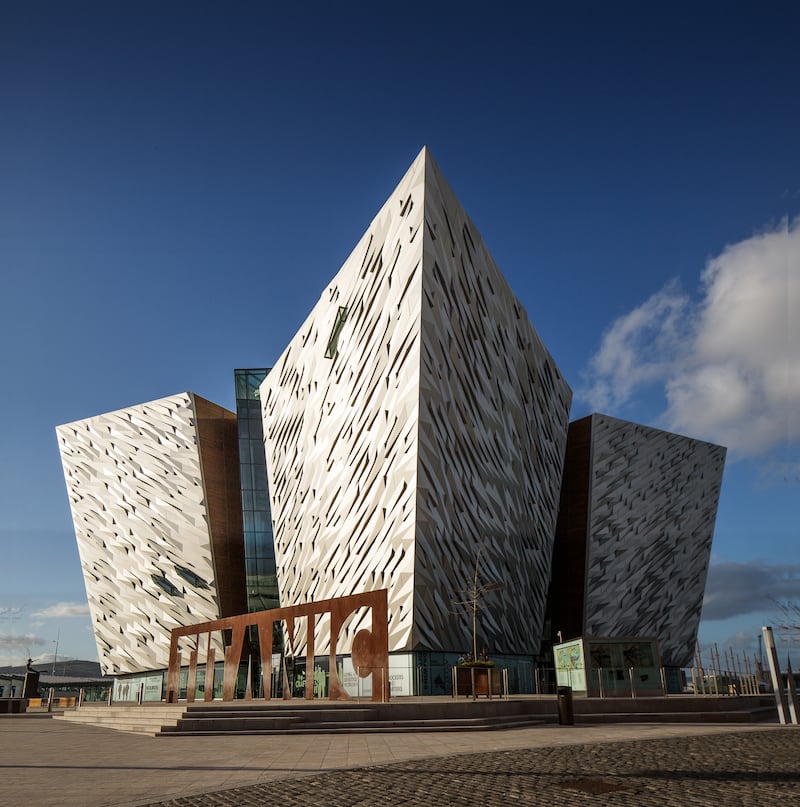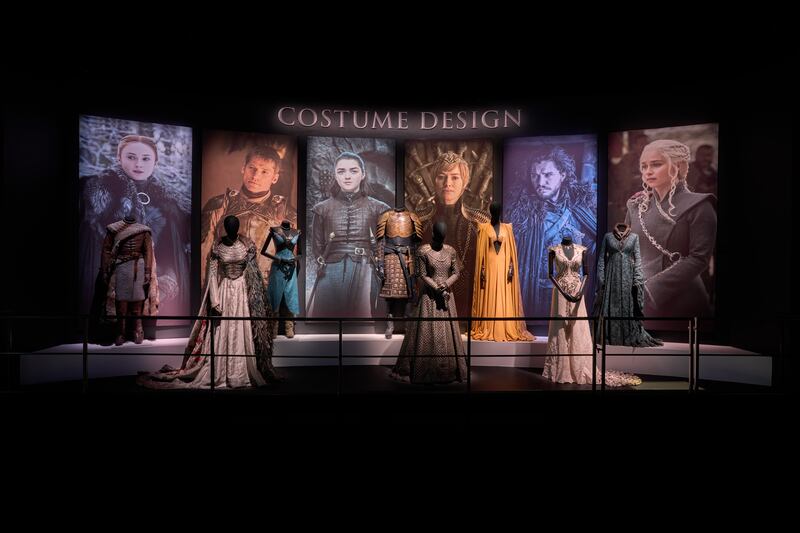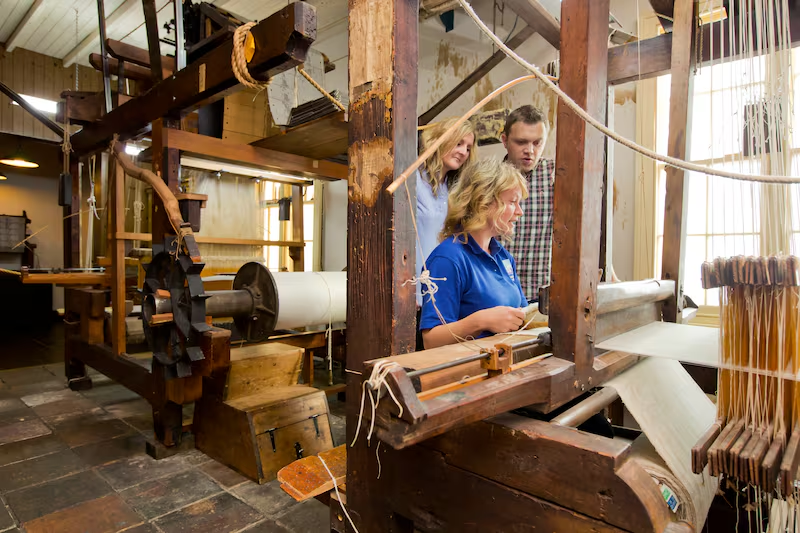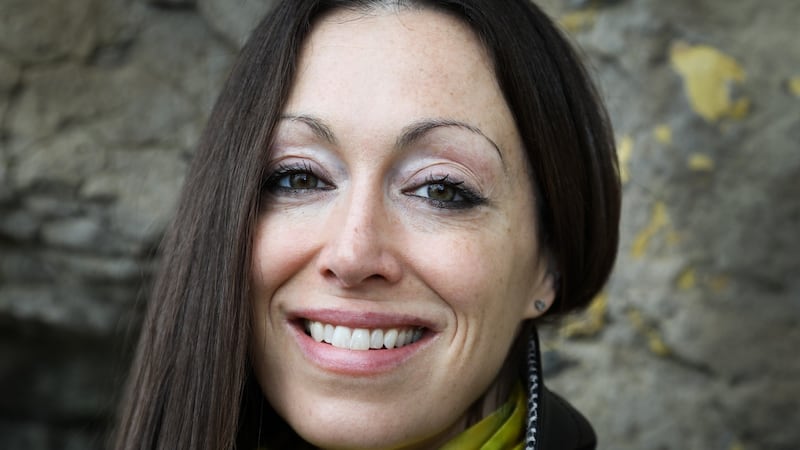I was initially sceptical when the Titanic Belfast visitor attraction was launched 10 years ago, a monument to Belfast’s maritime heritage on the site of the Harland & Wolff shipyard where the Titanic was built. I could see how you would go once, but would you go back? Well, here’s me, a decade later, going back and actually getting a lot out of it.
The building is very easy on the eye and equally a lot of imagination has gone into the displays, which are informative without being dry. They cover every angle imaginable, from the building of the ship and its fitting out to the circumstances in which it sank and the subsequent inquiries, but also its portrayal in popular culture. You can look up the names of everyone on the ship and learn their fate. My two namesakes never made it. The ticket price also covers a tour of the tender SS Nomadic, built to transfer passengers to and from the Titanic. Whatever about flogging a dead horse, Belfast has shown what you can salvage from a sunken ship.
There have been quite a few changes since we were here last. The drawing offices, where draughtsmen designed the Titanic and a fleet of other vessels, have been transformed into the Titanic Hotel, where we are staying. The art deco nautical theme is subtly done, and the bar is particularly grand, with parquet floor and vaulted, glazed ceiling, without being intimidating. Enjoy a walk along the Maritime Mile, Belfast’s historic waterfront, before dining in the hotel’s Wolff Grill restaurant overlooking the harbour.

I’ve done the black taxi tours of the city’s trouble spots and peace walls before. This time, I thought I’d give the City Sightseeing Belfast hop-on, hop-off open-top bus tour (£18 adult, £11 child) a go but a loyalist parade was disrupting traffic so after waiting ages to escape Crumlin Road Gaol, we defect to the normal city buses. The service is remarkably good value: a Metro Daylink fare offers unlimited daily trips for just £3.50 (€4.12).
Fintan O’Toole: A cunning plan for Ireland’s sweaty moment of exposure to the glare of the orange sun king
‘These things happen’: Book returned to Kildare library after 74 years
Zoorassic Trail: Giant animatronic dinosaurs come to Dublin Zoo
National Concert Hall to spend more than €2½m on ‘world-class’ pipe organ
The imposing courthouse opposite the jail is derelict – dilapidation and an air of neglect are issues in Belfast as in Dublin – but the gaol has been well preserved. The building is fascinating but the exhibits make it, such as a Madonna and Child handicraft collage made by a prisoner in the 1970s, a notice of internment served on a James Doyle (no relation) in 1940, and the condemned cell with profiles of the eight men hanged there. The last, Robert McGladdery, executed on December 20th, 1961, is the subject of Eoin McNamee’s fine novel, Orchid Blue. The hangman, Albert Pierrepoint, was also a pub landlord, and there is an eerie photo of his pub, Help the Poor Struggler. There is a bar on site, whose name, The Last Drop Inn, is in dubious taste, though a pint of Guinness is just £3.
The Belfast 1798 Walking Tour is a step back much further in time, to a different period of unrest but perhaps a more hopeful, idealistic one, when Catholics and Presbyterians, radicalised by the French and American revolutions, formed the United Irishmen to try and throw off the yoke of the Anglican aristocracy. Sean Napier and Colm Dore have united to tell the story, bringing to life characters such as Wolfe Tone, Thomas Russell and Henry Joy McCracken, the beating heart of revolutionary Ulster when in Wordworth’s words, ”bliss was it in that dawn to be alive... but to be young was very heaven”. The tour takes place every Saturday at 11.30am at St George’s Church, High street, in front of the Albert Clock, Belfast’s answer to the Leaning Tower of Pisa. Standing four feet off the perpendicular, it inspired the motto: “It not only has the time, it also has the inclination.”
Belfast is unrecognisable from the city where I spent a year as a student in 1985. It is now a much livelier, safer, more diverse and welcoming place. But it has preserved an endearingly down-to-earth, unpretentious quality. And I am still drawn to places I loved back then, such as the National Trust-owned Crown Liquor Saloon, a Victorian bar which John Betjeman called “a many-coloured cavern” opposite the Europa Hotel. A short walk away is the redbrick Queen’s University, beside which is the Botanic Gardens, a green haven to relax in on a spring afternoon, with a magnificent Palm House. The adjacent Ulster Museum, refurbished to the tune of almost £20 million a decade ago, is well worth an afternoon of your time.
There is, of course, much more to Northern Ireland than Belfast and whether you want to see a bit of the countryside or break your journey if you’re heading up from the south, allow me to recommend a couple of gems in Co Down. The FE McWilliam Gallery in Banbridge showcases the work of Northern Ireland’s foremost sculptor, including his studio transported from his home in London’s Holland Park, along with an exhibition space (currently devoted to a Colin Davidson retrospective until September 10th) and a sculpture garden. The cafe, run by a local butcher and delicatessen, Quail’s, is exceptionally good. The Boulevard, an outlet shopping centre, is nearby, where you can purchase tickets for the Linen Mill Studios in Ballievy. Much of Game of Thrones was filmed there and it’s now home to the Game of Thrones Studio Tour.

The linen industry is a more universal part of Northern Ireland’s history than shipbuilding – no harm to the Titanic – so if you’re interested in exploring its rich social and industrial history, I recommend Bann Valley Heritage in Laurencetown, Co Down. Created by my neighbour, Norman Kerr, whose family has farmed locally for centuries, this fascinating and eclectic collection captures the history of the linen industry along the river Bann, from photos of the mills and mansions of the linen lords to displays of the tools and processes used to turn flax to fine cloth. There are also a range of displays demonstrating the evolution of everyday domestic life as well as farming, from tools and toys to tractors.
For another take on the theme, visit the Irish Linen Centre & Lisburn Museum in Lisburn’s Market Square, which hosts a permanent exhibition, Flax to Fabric: The Story of Irish Linen, as well as live spinning and weaving demonstrations. Fine samples of 17th-century damask as bought by European royalty are on display as well as a costume collection which includes designs by Sybil Connolly, whose dresses were worn by Jackie Kennedy, and stockings embroidered for Queen Victoria.

Where do the city’s top writers recommend to visitors?
Lucy Caldwell

It’s normally a selection of east Belfast streets that my writing shines a light on (or at least holds a candle for) but today I’m going to recommend the Ulster Museum in Botanic, in the leafy south of the city – and specifically the Lavery Room.
Sir John Lavery, one of the greatest artists ever to come from Belfast, donated 34 paintings to the newly-opened Municipal Museum and Art Gallery (as it then was) in 1929. The collection includes my favourite painting, Daylight Raid from my Studio Window, 7 July 1917. In it, a woman – Hazel Lavery, the artist’s wife – is kneeling on a sofa facing a large window, with her back to the viewer. In the distance are a number of barely visible planes: a dogfight in the sky, morning coffee in its silver pot momentarily abandoned for this brief tumult, as Yeats put it, in the clouds.
I could gaze at this painting all day. There is a scene set in front of it in my Belfast Blitz-set novel These Days and, by strange synchronicity, and to my delight, mine is not the only novel published this year to feature Lavery: Louise Kennedy’s searingly good Trespasses gives him a cameo too.
After the Lavery room, it might be nice to wander in the beautiful Botanic Gardens, and if you’re still on a literary bent, read Bernard MacLaverty’s story Glasshouses (from Blank Pages and Other Stories), which is set in the Palm House – designed by Sir Charles Lanyon and built by Richard Turner, predating the glasshouses at Kew and Glasnevin, and somehow surviving even the Belfast Blitz intact. What more do you need after this than a gin-in-a-tin or an ice-cream on the grass by the rose gardens?
But for something more substantial, just across the road is the bistro I had my first Saturday job in, then called Bonnie’s, now cafe Conor, the former studio of Belfast painter William Conor, another of the city’s greats. The artwork on the walls is by Neil Shawcross; the cherry scones, as they say, are no wee buns; and these days you get a better class of service than the 16-year-old who thought the mark of a good cappuccino was its height in inches.
Jan Carson

If, like me, you’re a fan of books and traybakes you need to check out the recently refurbished cafe in Belfast’s beautiful Linenhall Library. In my humble opinion they have the city’s best caramel squares. I’ve done quite a bit of research. The city’s best sandwich can be found at Lock Keeper’s Inn. Take a scenic walk along the Lagan from Shaw’s Bridge and treat yourself to a bacon, Brie and cranberry one; best enjoyed outside on a riverside bench. Neill’s Hill in Ballyhackamore over in the east is great for brunch and they also have an eclectic and rotating selection of the most delicious home-baked scones in Belfast.
John Self

There’s life outside the city centre in Belfast too – venture east, past the ever-expanding Titanic Quarter, to the Belmont and Ballyhackamore areas where you can eat everything from Bangladeshi to pizza-free Italian, take in (or take part in) a show at the Strand Arts Centre, and hang out in the resplendent grounds of Stormont Estate, where the current absence of politicians makes it all the more relaxing.
For more information check out visitbelfast.com. Martin Doyle was a guest of Harcourt, which offers a four-night Northern Escape package for two people, with two nights’ accommodation in the Titanic Hotel Belfast and two nights at Lough Eske Castle, from €840. titanichotelbelfast.com















